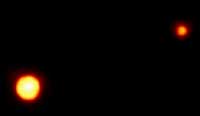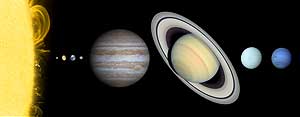
Pluto Stripped of Planetary Status
24 August 2006In a historic move the International Astronomical Union (IAU) has resolved the definition of a planet which make's Pluto a "dwarf planet" rather than its planetary status that it has held since 1930 when it was discovered by Clyde Tombaugh. The remaining 8 planets in the solar system are Mercury, Venus, Earth, Mars, Jupiter, Saturn, Uranus, and Neptune. NASA has already visited these eight planets and has its New Horizons spacecraft en route to Pluto.

For many astronomers this move fixes an age long mistake in astronomical decision making. What is exciting about the decision is that it opens up a whole new class of astronomical objects or "dwarf planets" of which Pluto, Ceres, and 2003 UB313 (temporary name) are the first members. The IAU resolutions are as follows:
The IAU therefore resolves that "planets" and other bodies in our Solar System be defined into three distinct categories in the following way:(1) A "planet" is a celestial body that (a) is in orbit around the Sun, (b) has sufficient mass for its self-gravity to overcome rigid body forces so that it assumes a hydrostatic equilibrium (nearly round) shape, and (c) has cleared the neighbourhood around its orbit.
(2) A "dwarf planet" is a celestial body that (a) is in orbit around the Sun, (b) has sufficient mass for its self-gravity to overcome rigid body forces so that it assumes a hydrostatic equilibrium (nearly round) shape, (c) has not cleared the neighbourhood around its orbit, and (d) is not a satellite.
(3) All other objects except satellites orbiting the Sun shall be referred to collectively as "Small Solar-System Bodies".
Under these rules Pluto is disqualified as a planet because its orbit overlaps with Neptune's.
Ceres, which orbits in a belt between Mars and Jupiter and is the largest known asteroid. In 2007, NASA will launch the Dawn spacecraft on a mission to study Ceres, which the astronomers have placed in the dwarf planet category, alongside Pluto. The dwarf planet family also includes 2003 UB313, now called Eris. When Dr. Mike Brown of Caltech and his colleagues announced last summer that they'd discovered the object, which is bigger and farther away than Pluto, many astronomers decided it was time to figure out once and for all, "What exactly is a planet, anyway?" In addition to Pluto, Ceres and Eris, the astronomical union has a dozen potential dwarf planets on its watchlist.
What's to become of the other objects in our solar system neighborhood, the ones that are not planets, not dwarf planets and not moons? The organization has decided that most asteroids, comets and other small objects will be called "small solar-system bodies."
Despite the establishment of these three distinct categories, there are bound to be gray areas. As technologies improve and more objects are found, the International Astronomical Union will set up a process to decide which categories are most appropriate for specific objects.
Even before the discovery of Xena, not all was calm in the planetary world. There was debate after Clyde Tombaugh discovered Pluto in 1930. With its small size, distant location and odd orbit, some questioned whether Pluto was really a planet or just an icy remnant of the planet-forming process.
Although the revamping of our solar system might seem unsettling, it's really nothing new. In fact, when Ceres was first discovered in 1801, it was called a planet, as were several similar objects found later. But when the count kept on growing, astronomers decided "enough is enough," and they demoted Ceres and its siblings, placing them in a new category, called asteroids.